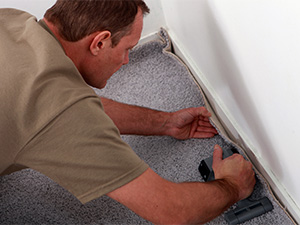
Stretched carpet is a common issue. However common it may be, it can be dangerous. Those wrinkles, ripples, and bulges can become trip, slip, and fall hazards. Here is what causes the problem and what to do about it.
Stretched carpet is a common issue seen in homes and commercial spaces alike. It occurs when the carpet fibers become loose and pull away from the backing, resulting in wrinkles, ripples, or bulges across the surface.
Several factors contribute to carpet stretching, including improper installation, heavy foot traffic, excessive humidity, and changes in temperature. Understanding the causes can help prevent recurrence and help find effective solutions.
Improper installation is a primary cause of stretched carpet. When carpet is installed without sufficient tension or using inadequate tools, it is prone to stretching over time. Additionally, incorrect seam placement or improper padding can worsen the problem. High levels of foot traffic can also contribute to carpet stretching, as constant pressure on the fibers can cause them to loosen and shift over time.
Humidity and temperature changes can further aggravate carpet stretching. Moisture in the air can weaken the carpet fibers and backing, making them more susceptible to stretching. Likewise, changes in temperature can cause the carpet to expand and contract, leading to wrinkles and bulges.
Fortunately, there is more than one way to fix stretched carpet and restore its appearance and functionality. One common approach is to re-stretch the carpet using a power stretcher. This involves pulling the carpet tight and re-securing it to the tack strips along the edges of the room. Professional carpet installers typically use this method to ensure a tight, smooth finish.
For smaller areas of stretching, a knee kicker may suffice. This tool allows for manual stretching of the carpet in localized areas, such as near doorways or corners. However, it may not provide as tight a fix as a power stretcher.
In some cases, it may be necessary to replace the carpet padding to address underlying issues contributing to stretching. Damaged or worn padding can reduce the carpet’s support and increase stretching problems. By replacing the padding, homeowners can provide better support for the carpet and prevent future stretching.
Regular maintenance can also help prevent carpet stretching. Vacuuming regularly to remove dirt and debris can reduce wear on the carpet fibers. Periodic carpet cleaning can also help with dirt and debris removal. Using furniture pads and area rugs can distribute weight more evenly and protect high-traffic areas.
Stretched carpet is a common issue. However common it may be, it can be dangerous. Those wrinkles, ripples and bulges can become trip, slip and fall hazards. By understanding the causes and implementing proper fixes, such as re-stretching or replacing padding, homeowners can reduce the risk of accidents and restore their carpet’s appearance and prolong its lifespan.
